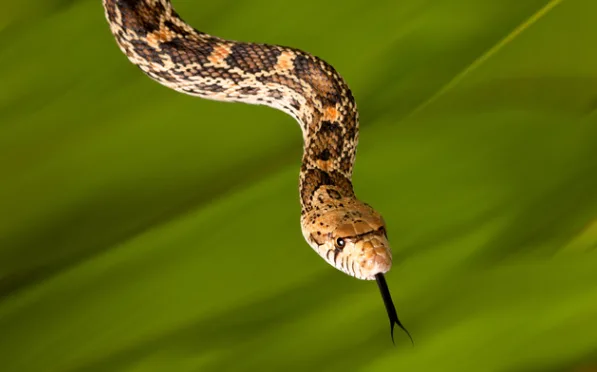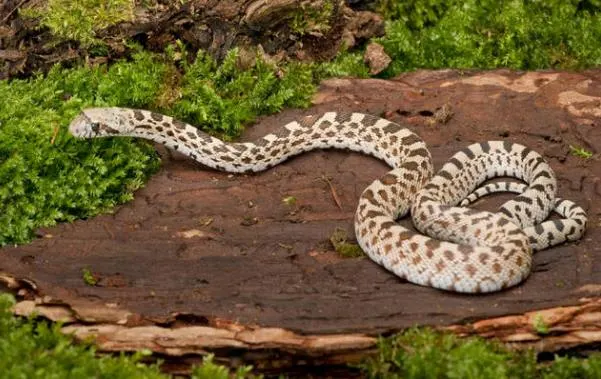The bullsnake (Pituophis catenifer sayi) is a remarkable reptile that plays a crucial role in the ecosystems of North America. Often misunderstood due to its size and behavior, the bullsnake is a nonvenomous species known for its impressive length and its beneficial role in controlling rodent populations. In this blog post, we’ll delve into the world of bullsnakes, exploring their characteristics, habitat, behavior, and why they are considered a farmer’s best ally.

Table of Contents
What is a Bullsnake?
The bullsnake is one of the largest snakes in North America, reaching lengths of up to 8 feet, though most typically measure between 4 to 6 feet. They are robust, muscular snakes with a body adorned in a pattern of dark dorsal blotches on a background that can range from yellow, cream, or beige to reddish-brown. This pattern often leads to confusion with the venomous rattlesnake, particularly since bullsnakes have evolved to mimic some of the rattlesnake’s defensive behaviors, such as hissing and tail vibration.
Belonging to the Colubridae family, bullsnakes are a subspecies of the gopher snake. Their scientific name, Pituophis catenifer sayi, is rooted in Greek and Latin, referring to their chain-like body pattern and their resemblance to pine serpents.
Habitat and Distribution
Bullsnakes are native to North America, with their range extending from southern Canada through the central United States and into northern Mexico. They thrive in a variety of open habitats, including prairies, grasslands, farmlands, and sandy areas where they can easily dig and find shelter. Bullsnakes are also commonly found in old gopher burrows, which they either take over or expand to suit their needs.
Their preference for these habitats makes them particularly valuable to farmers, as they help control populations of rodents and other pests that can damage crops.
Diet and Hunting Behavior
Bullsnakes are carnivorous, primarily preying on small mammals such as mice, rats, and gophers. They are also known to eat birds, bird eggs, lizards, and even small rabbits. Their hunting technique involves using their keen sense of smell and sight to locate prey, which they then subdue through constriction. Despite their large size, bullsnakes are agile hunters and are even capable of climbing trees to raid bird nests.
One of the fascinating aspects of bullsnakes is their role in controlling rodent populations. By keeping the numbers of these pests in check, bullsnakes indirectly contribute to protecting crops, making them a valuable asset in agricultural areas. This has earned them the nickname “the farmer’s friend.”
Bullsnake Behavior and Defense Mechanisms
Bullsnakes are generally solitary creatures, coming together only during the mating season. They are diurnal, meaning they are most active during the day, although they may be crepuscular (active during twilight) in hotter climates to avoid the midday heat.
When threatened, bullsnakes employ a series of defensive behaviors to deter predators. These include hissing loudly, flattening their heads, and vibrating their tails to mimic a rattlesnake’s rattle. This mimicry is so effective that many predators and even humans mistake them for the venomous rattlesnake. However, bullsnakes are nonvenomous and pose little danger to humans. While they can bite if provoked, their bite is not venomous and is typically only a last resort when they feel cornered.
Bullsnakes in Captivity
Bullsnakes have become a popular choice among reptile enthusiasts due to their impressive size and relatively easy care requirements. In captivity, they can live up to 30 years, significantly longer than their average lifespan of 12 years in the wild. However, keeping a bullsnake as a pet requires a commitment to providing a large enough enclosure, a suitable environment, and a diet that mimics what they would eat in the wild.
Breeders have developed various color morphs of bullsnakes, including albino, ghost, and leucistic varieties. These snakes, with their unique colorations, have become particularly sought after in the pet trade.
Bullsnakes and Conservation
The bullsnake is currently listed as a species of “Least Concern” by conservation authorities. This means that their populations are stable, and there is no immediate threat to their survival. However, like all wildlife, bullsnakes face challenges from habitat loss due to agricultural expansion, urbanization, and human encroachment. Efforts to conserve natural habitats are essential to ensure that bullsnakes and other wildlife continue to thrive.
Q&A: Common Questions About Bullsnakes
Q: Are bullsnakes venomous?
A: No, bullsnakes are nonvenomous. They do not possess venom glands or fangs to deliver venom. While they can bite if threatened, their bite is not dangerous to humans.
Q: How do bullsnakes hunt their prey?
A: Bullsnakes use their keen sense of smell and sight to track down prey. They strike quickly, grabbing the prey with their backward-curved teeth and constricting it with their muscular coils. Constriction cuts off the blood flow to the prey, which the snake then swallows whole.
Q: Where do bullsnakes live?
A: Bullsnakes are found across North America, from Canada to Mexico. They prefer open habitats such as grasslands, prairies, and farmlands, often sheltering in abandoned gopher burrows.
Q: What do bullsnakes eat?
A: Bullsnakes primarily eat small mammals like mice, rats, and gophers. They will also eat birds, bird eggs, lizards, and small rabbits. Juvenile bullsnakes may feed on insects and smaller prey like baby mice.
Q: Are bullsnakes aggressive?
A: Bullsnakes are not inherently aggressive but will defend themselves if they feel threatened. They use a combination of hissing, tail vibrating, and striking to ward off potential predators.
Q: Can bullsnakes kill rattlesnakes?
A: While it is uncommon, bullsnakes have been known to kill and eat rattlesnakes. However, this behavior is rare and not a significant part of their diet.

Q: How long do bullsnakes live?
A: In the wild, bullsnakes typically live around 12 years, but in captivity, with proper care, they can live up to 30 years.
Q: Is a bullsnake a good pet?
A: Bullsnakes can make good pets for experienced snake owners due to their size and temperament. They require a large enclosure, proper diet, and consistent care. Some bullsnakes are docile, while others may be more temperamental.
Bullsnakes are fascinating creatures that play a vital role in maintaining the balance of ecosystems across North America. Their ability to control rodent populations makes them a valuable ally to farmers, while their impressive size and unique behavior make them intriguing subjects of study and admiration. Understanding and appreciating the role of bullsnakes in the environment is crucial for their conservation and the continued health of the habitats they inhabit. Whether encountered in the wild or kept as a pet, bullsnakes remind us of the intricate and essential relationships between species in our world.
- Enchi Ball Python: A Unique and Stunning Morph of Python regius - March 27, 2025
- Emerald Tree Monitor: The Enigmatic Green Guardian of the Rainforest - March 26, 2025
- The Egyptian Cobra (Naja haje): A Fascinating Serpent - March 25, 2025
